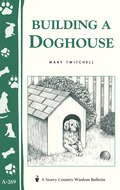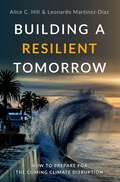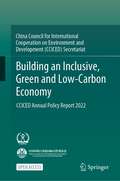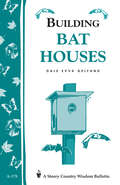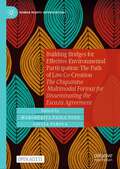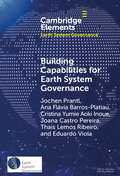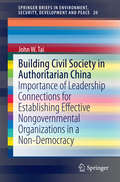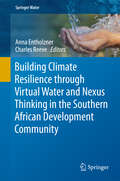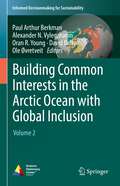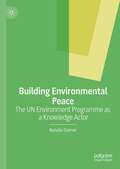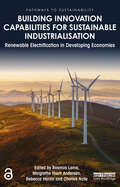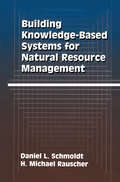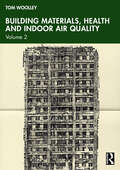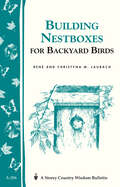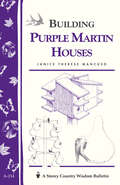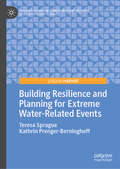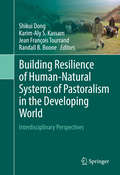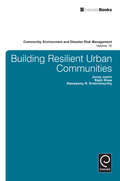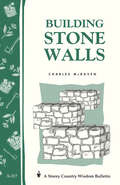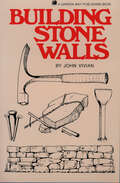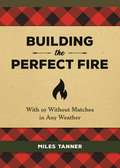- Table View
- List View
Building a Doghouse: (Storey's Country Wisdom Bulletins A-269) (Storey Country Wisdom Bulletin)
by Mary TwitchellBuild a Doghouse That's Just Right for Your Dog!While your dog may be a full-fledged member of the family, there are times when you must put him or her outdoors. Some dogs, for example, become over enthusiastically friendly when visitors appear, even to the point of knocking down your unsuspecting guests. Other dogs enjoy having some time to themselves in the backyard. Whatever the reason that shepherds the dog out the door, a nearby doghouse within a fenced-in area provides a protected, private space for your dog and peace of mind for you. A proper doghouse is a canine retreat, a place where your dog can hide from the hot sun, the cold rain, the harsh wind, and the worries of the world. Mary Twitchell takes you through all the options for building or buying a comfortable and cozy shelter for your canine companion. Whether you want to modify a barrel, buy a molded plastic shelter, or build a wooden doghouse, you'll find all the information you need right here, from choosing the right site to proper building techniques to encouraging your dog to use the new doghouse.
Building a Resilient Tomorrow: How to Prepare for the Coming Climate Disruption
by Alice C. Hill Leonardo Martinez-DiazClimate change impacts-more heat, drought, extreme rainfall, and stronger storms-have already harmed communities around the globe. Even if the world could cut its carbon emissions to zero tomorrow, further significant global climate change is now inevitable. Although we cannot tell with certainty how much average global temperatures will rise, we do know that the warming we have experienced to date has caused significant losses, and that the failure to prepare for the consequences of further warming may prove to be staggering. Building a Resilient Tomorrow does not dwell on overhyped descriptions of apocalyptic climate scenarios, nor does it travel down well-trodden paths surrounding the politics of reducing carbon emissions. Instead, it starts with two central facts: climate impacts will continue to occur, and we can make changes now to mitigate their effects. While squarely confronting the scale of the risks we face, this pragmatic guide focuses on solutions-some gradual and some more revolutionary-currently being deployed around the globe. Each chapter presents a thematic lesson for decision-makers and engaged citizens to consider, outlining replicable successes and identifying provocative recommendations to strengthen climate resilience. Between animated discussions of ideas as wide-ranging as managed retreat from coastal hot-zones to biological approaches for resurgent climate-related disease threats, Alice Hill and Leonardo Martinez-Diaz draw on their personal experiences as senior officials in the Obama Administration to tell behind-the-scenes stories of what it really takes to advance progress on these issues. The narrative is dotted with tales of on-the-ground citizenry, from small-town mayors and bankers to generals and engineers, who are chipping away at financial disincentives and bureaucratic hurdles to prepare for life on a warmer planet. For readers exhausted by today's paralyzing debates on yearly "fluke" storms or the existence of climate change, Building a Resilient Tomorrow offers better ways to manage the risks in a warming planet, even as we work to limit global temperature rise.
Building a Resilient Tomorrow: How to Prepare for the Coming Climate Disruption
by Leonardo Martinez-Diaz Alice C. HillClimate change impacts-more heat, drought, extreme rainfall, and stronger storms-have already harmed communities around the globe. Even if the world could cut its carbon emissions to zero tomorrow, further significant global climate change is now inevitable. Although we cannot tell with certainty how much average global temperatures will rise, we do know that the warming we have experienced to date has caused significant losses, and that the failure to prepare for the consequences of further warming may prove to be staggering. Building a Resilient Tomorrow does not dwell on overhyped descriptions of apocalyptic climate scenarios, nor does it travel down well-trodden paths surrounding the politics of reducing carbon emissions. Instead, it starts with two central facts: climate impacts will continue to occur, and we can make changes now to mitigate their effects. While squarely confronting the scale of the risks we face, this pragmatic guide focuses on solutions-some gradual and some more revolutionary-currently being deployed around the globe. Each chapter presents a thematic lesson for decision-makers and engaged citizens to consider, outlining replicable successes and identifying provocative recommendations to strengthen climate resilience. Between animated discussions of ideas as wide-ranging as managed retreat from coastal hot-zones to biological approaches for resurgent climate-related disease threats, Alice Hill and Leonardo Martinez-Diaz draw on their personal experiences as senior officials in the Obama Administration to tell behind-the-scenes stories of what it really takes to advance progress on these issues. The narrative is dotted with tales of on-the-ground citizenry, from small-town mayors and bankers to generals and engineers, who are chipping away at financial disincentives and bureaucratic hurdles to prepare for life on a warmer planet. For readers exhausted by today's paralyzing debates on yearly "fluke" storms or the existence of climate change, Building a Resilient Tomorrow offers better ways to manage the risks in a warming planet, even as we work to limit global temperature rise.
Building an Inclusive, Green and Low-Carbon Economy: CCICED Annual Policy Report 2022
by CCICEDThis open access book introduces the major environmental green development issues from six major themes carbon neutrality, nature-based solution, watershed management and climate adaptation, BRI green development, sustainable food supply chain, ecosystem-based integrated ocean management focusing on the progress of China’s environment and development policies from 2021 accomplishments. It is based on the research outputs of CCICED in the year of 2021, which marks China’s start point of implementation of its 14th Five-Year Plan when world economy also strived to recover from the pandemic.
Building Bat Houses: Storey's Country Wisdom Bulletin A-178 (Storey Country Wisdom Bulletin)
by Dale Evva GelfandSince 1973, Storey's Country Wisdom Bulletins have offered practical, hands-on instructions designed to help readers master dozens of country living skills quickly and easily. There are now more than 170 titles in this series, and their remarkable popularity reflects the common desire of country and city dwellers alike to cultivate personal independence in everyday life.
Building Bridges for Effective Environmental Participation: The Chiquitano Multimodal Format for Disseminating the Escazú Agreement (Human Rights Interventions)
by Margherita Paola Poto Giulia ParolaThis open-access book aims to explore and promote indigenous participation in legal design and visual law, with a specific focus on co-creating a visual representation of the Escazu Agreement in collaboration with the Chiquitano people. This project stands out as a unique and transformative endeavor, offering distinctive features and a range of benefits to its readers and stakeholders.
Building Capabilities for Earth System Governance (Elements in Earth System Governance)
by null Jochen Prantl null Ana Flávia Barros-Platiau null Cristina Yumie Inoue null Joana Castro Pereira null Thais Lemos Ribeiro null Eduardo ViolaThis Element develops a new Strategic Capabilities Framework for studying and steering complex socio-ecological systems. It is driven by the central question of what are the most essential capabilities that ought to be fostered for addressing the fundamental 21st Century environmental challenges and Earth system transformations. The author's objective is to innovate transformative ideas toward better climate and ocean governance that are of interest both to academics and policymakers in the field. Rather than investigating the design and effectiveness of institutions in governing the climate and the oceans, the authors offer an alternative approach starting from the assumption that global governance arrangements must be informed by the capabilities of the communities affected. This Element aims to offer out-of-the-box thinking about capabilities-focused and community-centered frameworks that align multi-level systems of governance with the fundamental challenges of global environmental change. This title is also available as Open Access on Cambridge Core.
Building Civil Society in Authoritarian China: Importance of Leadership Connections for Establishing Effective Nongovernmental Organizations in a Non-Democracy (SpringerBriefs in Environment, Security, Development and Peace #20)
by John W. TaiHow is modern civil society created? There are few contemporary studies on this important question and when it is addressed, scholars tend to emphasize the institutional environment that facilitates a modern civil society. However, there is a need for a new perspective on this issue. Contemporary China, where a modern civil society remains in a nascent stage, offers a valuable site to seek new answers. Through a comparative analysis of nongovernmental organizations (NGOs) in today’s China, this study shows the importance of the human factor, notably the NGO leadership, in the establishment of a modern civil society. In particular, in recognition of the social nature of NGOs, this study engages in a comparative examination of Chinese NGO leaders’ state linkage, media connections and international ties in order to better understand how each factor contributes to effective NGOs.
Building Climate Resilience through Virtual Water and Nexus Thinking in the Southern African Development Community (Springer Water)
by Anna Entholzner Charles ReeveThis book puts the spotlight on Southern Africa, presenting a cutting-edge concept never previously explored in the context of climate change and putting forward arguments for regional integration and cooperation. The Climate Resilient Infrastructure Development Facility (CRIDF) is the new water infrastructure program of the UK Department for International Development (DFID) for Southern Africa. The CRIDF promotes the establishment of small to medium-scale infrastructure across the Southern African Development Community (SADC) through technical assistance aimed at developing sustainable pro-poor projects, while also facilitating access to the financial resources needed to deliver said infrastructure. Further, it focuses on regional water resource management goals and basin plans, as well as on building climate resilience for the beneficiary communities. The Facility’s Virtual Water and Nexus Project works to improve regional peace dividends by translating the Nexus concept into national and regional policies; it ultimately promotes sovereign security through greater regional integration across the water, food and energy sectors, while taking into account potential benefits in connection with carbon sequestration and emission mitigation.
Building Common Interests in the Arctic Ocean with Global Inclusion: Volume 2 (Informed Decisionmaking for Sustainability)
by Oran R. Young Paul Arthur Berkman Alexander N. Vylegzhanin David A. Balton Ole Rasmus ØvretveitThis book contains an inclusive compilation of perspectives about the Arctic Ocean with contributions that extend from Indigenous residents and early career scientists to Foreign Ministers, involving perspectives across the spectrum of subnational-national-international jurisdictions. The Arctic Ocean is being transformed with global climate warming into a seasonally ice-free sea, creating challenges as well as opportunities that operate short-to-long term, underscoring the necessity to make informed decisions across a continuum of urgencies from security to sustainability time scales. The Arctic Ocean offers a case study with lessons that are especially profound at this moment when humankind is exposed to a pandemic, awakening a common interest in survival across our globally-interconnected civilization unlike any period since the Second World War. This second volume in the Informed Decisionmaking for Sustainability series reveals that building global inclusion involves common interests to address changes effectively “for the benefit of all on Earth across generations.”
Building Environmental Peace: The UN Environment Programme as a Knowledge Actor
by Natalia DalmerBy analyzing the UN Environment Programme’s (UNEP’s) contribution to peacebuilding, this book aims to show how international bureaucracies develop knowledge and thereby come to matter on the world stage. Portraying UNEP as an open system, it explores how a growing understanding within the Programme of how environmental degradation shapes insecurities and vice versa has motivated its work on peacebuilding. The theoretical part of this book addresses knowledge, open systems, and knowledge creation. It then presents a historical discussion of UNEP’s development in an open system context. Finally, it investigates how knowledge emergence on the linkage between the environment, conflicts, and insecurities influenced UNEP’s interests and its work on environmental peacebuilding.
Building Innovation Capabilities for Sustainable Industrialisation: Renewable Electrification in Developing Economies (Pathways to Sustainability)
by Rasmus Lema Margrethe Holm Andersen Rebecca Hanlin Charles NzilaThis book argues that renewable electrification in developing countries provides important opportunities for local economic development, but new pathways are required for turning these opportunities into successful reality. Building Innovation Capabilities for Sustainable Industrialisation offers a novel input into the debate on development of capabilities for sustainable industrialisation and delivers key insights for both researchers and policy makers when it comes to the question of how to increase the economic co-benefits of renewables expansion. The chapters in the book use a tailored analytical framework in their studies of renewable electrification efforts in Kenya and other countries in sub-Saharan Africa. They draw on a mix of project, sector and country level case studies to address questions such as: What capabilities are developed through on-going renewable electrification projects in developing economies? How can the expansion of renewable electrification be supported in a way that also encourages sustainable economic development? What role do international linkages (South-South and North-South) play and what role should they play in the greening of energy systems in developing economies? The authors provide a new understanding of how green transformation and sustainable industrialisation can be combined, highlighting the opportunities and constraints for local capability building and the scope for local policy action. This book will be of great interest to students and scholars of development studies, energy studies, sustainability and sustainable development, as well as practitioners and policy makers working in development organisations and national governments.
Building Innovation Capabilities for Sustainable Industrialisation: Renewable Electrification in Developing Economies (Pathways to Sustainability)
by Rasmus Lema, Margrethe Holm Andersen, Rebecca Hanlin and Charles NzilaThis book argues that renewable electrification in developing countries provides important opportunities for local economic development, but new pathways are required for turning these opportunities into successful reality. Building Innovation Capabilities for Sustainable Industrialisation offers a novel input into the debate on development of capabilities for sustainable industrialisation and delivers key insights for both researchers and policy makers when it comes to the question of how to increase the economic co-benefits of renewables expansion. The chapters in the book use a tailored analytical framework in their studies of renewable electrification efforts in Kenya and other countries in sub-Saharan Africa. They draw on a mix of project, sector and country level case studies to address questions such as: What capabilities are developed through on-going renewable electrification projects in developing economies? How can the expansion of renewable electrification be supported in a way that also encourages sustainable economic development? What role do international linkages (South-South and North-South) play and what role should they play in the greening of energy systems in developing economies? The authors provide a new understanding of how green transformation and sustainable industrialisation can be combined, highlighting the opportunities and constraints for local capability building and the scope for local policy action. This book will be of great interest to students and scholars of development studies, energy studies, sustainability and sustainable development, as well as practitioners and policy makers working in development organisations and national governments.
Building Knowledge-Based Systems for Natural Resource Management
by Daniel L. Schmoldt H. Michael RauscherIf one were forced to use a single key word to describe the decade of the 1980's, a very prominent one would be "technology. " Leading the forefront of tech nology advancement were breakthroughs in electronics. Devices that were uncommon or unknown in 1980 became commonplace, and almost indispens able, by 1989. This trend has continued into the 1990's and it does not seem to be abating in any way. Microwave ovens, video recorders, telephone answer ing machines, compact disc players, computers, and a host of smaller or less sophisticated devices now appear in most households. The development of small and inexpensive computers, i. e. , personal computers, has placed computing resources within reach of many more people. In addition, many traditional, and largely mechanical devices, have been enhanced by electronics. For example, specialized microprocessors are combined with arrays of electronic sensors to control and monitor sophisticated engineering components in most new auto mobiles. In this and many other ways, we are touched by the new electronics in almost every aspect of our daily lives. Initially, personal computers were little more than toys. They contained only a small fraction of the computing power of their immediate ancestors, the mini computers and mainframe computers. However, rapid improvements in integ rated circuit design and chip manufacture produced regular reductions in size and cost of computer components. During the same time, processor speed and sophistication increased.
Building Materials, Health and Indoor Air Quality: Volume 2
by Tom WoolleyIn Building Materials, Health and Indoor Air Quality: Volume 2 Tom Woolley uses new research to continue to advocate for limiting the use of hazardous materials in construction and raise awareness of the links between pollutants found in building materials, poor indoor air quality and health problems. Chapters in this volume reinforce previous arguments and present new ones covering: Further evidence of the health impacts of hazardous emissions from materials Hazardous materials to be avoided and why Fire and smoke toxicity – the Lakanal House and Grenfell Tower legacy Sub-standard retrofits leading to damp and mould in previously sound houses A critical review of recent reports from UK Government and others on air quality and health problems including policy changes on flame retardants Growing evidence of cancer risks and the failure of cancer research organisations to address these issues A critical review of recent climate change and zero carbon policies and a discussion on whether extreme energy efficiency is a good thing This book asks some important and, for some, uncomfortable questions, but in doing so it brings to light important areas for research and provides much needed guidance for architects, engineers, construction professionals, students and researchers on hazardous materials and how to reduce their use and design and build healthier buildings for all occupants.
Building Materials, Health and Indoor Air Quality: Volume 2
by Tom WoolleyIn Building Materials, Health and Indoor Air Quality: Volume 2 Tom Woolley uses new research to continue to advocate for limiting the use of hazardous materials in construction and raise awareness of the links between pollutants found in building materials, poor indoor air quality and health problems. Chapters in this volume reinforce previous arguments and present new ones covering: Further evidence of the health impacts of hazardous emissions from materials Hazardous materials to be avoided and why Fire and smoke toxicity – the Lakanal House and Grenfell Tower legacy Sub-standard retrofits leading to damp and mould in previously sound houses A critical review of recent reports from UK Government and others on air quality and health problems including policy changes on flame retardants Growing evidence of cancer risks and the failure of cancer research organisations to address these issues A critical review of recent climate change and zero carbon policies and a discussion on whether extreme energy efficiency is a good thing This book asks some important and, for some, uncomfortable questions, but in doing so it brings to light important areas for research and provides much needed guidance for architects, engineers, construction professionals, students and researchers on hazardous materials and how to reduce their use and design and build healthier buildings for all occupants.
Building Nest Boxes for Backyard Birds: Storey's Country Wisdom Bulletin A-206 (Storey Country Wisdom Bulletin)
by Christyna M. Laubach René LaubachThis concise guide offers easy-to-follow, step-by-step instructions for building eight different nestboxes. Each nestbox is designed to attract and house different kinds of backyard birds, including bluebirds, swallows, wrens, chickadees, nuthatches, Red-Bellied Woodpeckers, Northern Flickers, Wood Ducks, Hooded Mergansers, American Kestrals, Screech Owls, Northern Saw-Whet Owls, and Great Crested or Ash-Throated Flycatchers.
Building Purple Martin Houses: Storey's Country Wisdom Bulletin A-214 (Storey Country Wisdom Bulletin)
by Janice Therese MancusoAttract and maintain a purple martin colony! Janice Mancuso shows you exactly how to do it. From finding the right site and choosing the best housing materials to constructing a martin house with suitable entrance holes and predator guards, you’ll find everything you need to know in this concise guide.
Building Resilience and Planning for Extreme Water-Related Events (Palgrave Studies in Climate Resilient Societies)
by Teresa Sprague Kathrin Prenger-BerninghoffThis book discusses what it means for cities to work toward and achieve resilience in the face of climate change. The content takes an urban planning perspective with a water-related focus, exploring the continued global and local efforts in improving disaster risk management within the water sphere. Chapters examine four cities in the US and Germany - San Francisco, San Diego, Solingen and Wuppertal - as the core case studies of the discussion. The chapters for each case delve into the current status of the cities and issues resilience must overcome, and then explore solutions and key takeaways learned from the implementation of various resilience approaches. The book concludes with a summary of cross-cutting themes, best-practice examples and a reflection on the relevance of the approaches to cases in the wider developing world. This book engages both practitioners and scientific audiences alike, particularly those interested in issues addressed by the Sendai Framework for Disaster Risk Reduction 2015-2030, the 2030 Agenda for Sustainable Development, the recent Water Action Decade 2018-2028 and the Rockefeller Foundation’s 100 Resilient Cities.
Building Resilience of Human-Natural Systems of Pastoralism in the Developing World: Interdisciplinary Perspectives
by Shikui Dong Karim-Aly S. Kassam Jean François Tourrand Randall B. BooneThis edited volume summarizes information about the situational context, threats, problems, challenges and solutions for sustainable pastoralism at a global scale. The book has four goals. The first goal is to summarize the information about the history, distribution and patterns of pastoralism and to identify the importance of pastoralism from social, economic and environmental perspectives. The results of an empirical investigation of the environmental and socio-economic implications of pastoralism in representative pastoral regions in the world are also incorporated.The second goal is to argue that breaking coupled human-natural systems of pastoralism leads to degradation of pastoral ecosystems and to create an analysis framework to assess the vulnerability of worldwide pastoralism. Our analysis framework provides approaches to help comprehensively understand the transitions and the impacts of human-natural systems in the pastoral regions in the world.The third goal is to identify the successful models in promoting coupled human-natural systems of pastoralism, and to learn lessons of breaking coupled human-cultural pastoralism systems through examining the representative cases in regions including Central Asia, Southern and Eastern Asia, Northern and Eastern Africa, the European Alps and South America.The fourth goal is to identify the strategies to build the resilience of the coupled human-natural systems of pastoralism worldwide. We hope that our book can facilitate the further examination of sustainable development of coupled human-natural systems of pastoralism by providing the summaries of existing data and information related to the pastoralism development, and by offering a framework for better understanding and analysis of their social, economic and environmental implications.
Building Resilient Urban Communities (Community, Environment and Disaster Risk Management #15)
by Jonas Joerin Rajib Shaw R. R. Krishnamurthy"How do urban communities in Asian cities experience the impacts of urbanisation and climate change? This book throws light on the ongoing processes of rapid urban transformation in many cities in developing countries, with particular reference to cities such as Chennai in India. Due to increasing demands on infrastructures and urban services, cities in developing countries are often pushed to the edge of collapse even when not in times of disaster. While such cities try to implement measures to safeguard the well-being of their citizens, looming impacts of climate change such as increasingly frequent and intense natural hazards pose new and additional challenges to their urban communities. This book connects critical issues relating to the general functioning of cities with climate-related disasters with the concept of resilience. Furthermore, this research takes a pro-solution stance, and demonstrates that individuals can form collective power to deliver added value before, during and after a disaster. The concept of resilience is applied to determine whether an urban community would be affected or damaged during a climate-related disaster, and to what extent."
Building Stone Walls: Storey's Country Wisdom Bulletin A-217 (Storey Country Wisdom Bulletin)
by Charles McRavenSince 1973, Storey's Country Wisdom Bulletins have offered practical, hands-on instructions designed to help readers master dozens of country living skills quickly and easily. There are now more than 170 titles in this series, and their remarkable popularity reflects the common desire of country and city dwellers alike to cultivate personal independence in everyday life.
Building Stone Walls
by John VivianRustic and charming or stately and proud, a well-built stone wall can add personality and beauty to your property. John Vivian&’s lively approach and step-by-step instructions encourage you to transform a pile of rocks into an enduring landscape feature with gates, retaining walls, or stiles to suit your needs. Whatever unique challenges come with your site — poor drainage, sloping ground, or low-quality rubble material — Vivian offers innovative designs and reproducible methods to help you build a beautiful, long-lasting wall.
Building the Perfect Fire: With or Without Matches in Any Weather
by Miles TannerDon't get left out in the cold! A definitive guide to the essential skill of setting, lighting, and maintaining a blaze both indoors and out. This go-to-guide for turning wood into heat, including starting a fire with everything from flints to forearms in any type of weather; tinders easily found in nature; identifying and gathering the best kindling and types of wood; efficient splitting and stacking configurations for different needs, such as cooking; and how to safely put out a blaze. Not just for survival, Building the Perfect Fire will also discuss using wood to create a welcoming fire, such as the crackling from birch wood or the colorful flames from an old apple tree.
Building the Perfect Fire: With or Without Matches in Any Weather
by Miles TannerDon't get left out in the cold! A definitive guide to the essential skill of setting, lighting, and maintaining a blaze both indoors and out. This go-to-guide for turning wood into heat, including starting a fire with everything from flints to forearms in any type of weather; tinders easily found in nature; identifying and gathering the best kindling and types of wood; efficient splitting and stacking configurations for different needs, such as cooking; and how to safely put out a blaze.Not just for survival, Building the Perfect Fire will also discuss using wood to create a welcoming fire, such as the crackling from birch wood or the colorful flames from an old apple tree.
